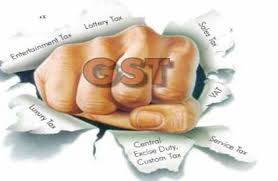Goods and Service Tax (GST) is by far one of the most awaited tax reform brought in our country. The Government is likely to push the implementation of GST with effect from April, 1st 2017.
GST is going to have a great impact on every sphere of business activity, be it supply chain, working capital, pricing etc. Many of the business decisions are taken based on the current taxation regime which may no longer be relevant in the new GST regime.
Here below are some essential points related to GST:-
- GST (Goods and Service Tax) would be levied on ‘supply’ of goods and services and hence the payment prevalent concepts of levy of excise on manufacturing, VAT/CST on sales, entry tax on goods in local area would no longer be relevant. The ambit of “supply” is quite wide and covers supply of goods and services without consideration from one taxable person to another.
- Currently, Central Taxes like Central Excise, Service Tax, Countervailing duties (CVD), Special Addition Duty (SAD), CST (Central Sales Tax) and State Taxes like VAT, CST, Entry Tax, Luxury Tax would get subsumed under GST. Customs is not considered in the ambit of GST and hence basic Customs Duty would continue on imports.
- Presently, the threshold limit for registration is Rs. 10 lakhs (Rs. 5 lakhs in case of North-East States and Sikkim) in the draft model law. Existing registered assesses would be migrated into GST, it will be done provisionally and then finally subject to furnishing of requisite information. Assessees have option to take business segment-wise registration.
- An option of composition levy is prescribed, if aggregate turnover of tax payer is less than 50 lakhs. The assessee who is adopting composition levy would be neither entitled to charge GST from its customers nor to avail credit of input tax. However, the composition levy is not allowable to the assessee who affects Inter-State supplies.
- The Provisions relating to payment of tax under reverse charge, tax deduction at source are expected to continue under GST regime for specified persons/transactions. Thus, additional compliances would continue on the part of recipients, so far as tax payments under reverse charge and deduction at source are concerned.
- Under GST, every assessees would have to upload invoice level outward supply details for B2B transactions. Details of inward supplies and tax credit would be auto-populated based on sales details uploaded by the vendor. Hence, a robust IT infrastructure at the end of both the supplier and recipient is critical for hassele free tax credits and avoid denial of credits due to mismatch issues.
- The liability for payment of GST would arise at the time of supply of goods and service. In terms of model law, receipt of advance payments for supply of goods and/or services would be considered as ‘time of supply’ and tax liability would arise on such advance receipt. However, receipt of goods and services is one of the pre-conditions for allowing input tax credit under GST and hence, even if GST is paid on advance payments, credit for the same would be available only on receipt of goods and services.
- Seamless flow of credit would be there under GST whereby CGST would be allowed to be set-off against CGST and IGST, SGST against SGST and IGST and IGST against IGST, CGST and SGST in that order. However, CGST credit will not be allowed to be set-off against SGST and vice versa. Thus, under GST, the present cost of 2% CST on inter-state sale will not be there as IGST would be totally fungible in the Destination State.
However, credit fungibility is state-centric as credit accumulated in one State cannot be used against tax pay-outs in another State.
- GST is a destination based consumption tax, which essentially implies that the revenue will accrue to the State where the consumer resides. This is unlike the present origin based levy where the revenue accrues to the origin state from where the movement originates.
- There would be dual GST i.e. both the Centre and the States would concurrently levy GST across the entire goods and services supply chain on a common base.
Centre would levy Central GST (CGST) and States would levy State GST (SGST) on every supply of goods and services within a State. Integrated GST (IGST) would be levied on all inter-state supplies by the Centre and then transferred to the Destination State. Unlike in the present scenario, IGST would have to be paid on all inter-state supplies, be it in the nature of a sale or stock transfer.
Visit us at Taxmantra.com-Business Maintenance for support, query and feedback.
 customersuccess@taxmantra.com
customersuccess@taxmantra.com Toll Free:
Toll Free:  Contact Us
Contact Us


